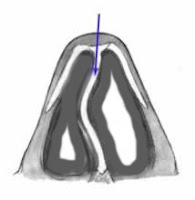The blunt answer is ABSOLUTELY nasal obstruction can be intermittent OR constant with a deviated septum!!! It's more a question of degree.
To begin with, a deviated septum is when the wall that separates the right and left nasal cavities is bent one way (green arrow) instead of being perfectly straight.
If there is no mucosal swelling, a person with a deviated septum is able to breath from both sides just fine. However, if there is the slightest bit of mucosal swelling from turbinate hypertrophy, allergies, upper respiratory infection, or any other environmental irritation, the side that is more narrow will obstruct much more readily with less swelling given there is just "less room" for swelling to occur before obstruction occurs.
Below is the same exact nose and septum as above, but with mucosal swelling present.
As you can see, with the same exact amount of swelling present, the deviated septum significantly influences how much space is present for air to pass through compared with a straight septum.
As such, even though a deviated septum may not technically be obstructive, given there is less room for any swelling to be accomodated, a patient will complain of nasal congestion and obstruction much more readily compared to someone with a straight septum due to the slightest changes in mucosal swelling.
How is a deviated septum fixed? Click here to read more.
Of course, one can try and control the mucosal swelling to avoid any surgical intervention, typically with steroid or anti-histamine nasal sprays. The downside is that such medications need to be used daily to prevent swelling from occurring in the first place.




















0 comments:
Post a Comment